Machine Learning vs. Numerical Weather Prediction: How AI Can Change the Existing Weather Forecasting Model

Numerical weather forecasting is the mainstream method of weather forecasting. It uses numerical integration to solve the state of the earth system grid by grid, which is a process of deductive reasoning.
However, as the resolution of weather forecasts continues to increase and the forecast time gradually lengthens, the computing power required for NWP models has increased rapidly, limiting its development. On the other hand, data-driven weather forecasting based on artificial intelligence has developed rapidly and has surpassed traditional methods in some areas.
How accurate are existing machine learning weather forecasts? How will artificial intelligence change weather forecasts? This article compares several data-driven machine learning weather forecast models and looks forward to the future development of weather forecasts.
Author | Xuecai
Editor | Sanyang
Numerical Weather Prediction: 45 Billion Partial Differential Equations
Numerical Weather Prediction (NWP) is the mainstream method in the field of weather forecasting.As early as the beginning of the 20th century, Abbe and Bjerknes proposed that people could use physical laws to predict the weather. Taking the current weather conditions as the initial value, the integration could solve the future weather. However, the research on meteorology was not in-depth enough at that time, and the computing level was relatively backward, so this idea was not realized.
In 1950, the University of Plönlingen attempted to use the first electronic computer to conduct weather forecasting. In 1954, the first real-time weather forecast was achieved in Stockholm.
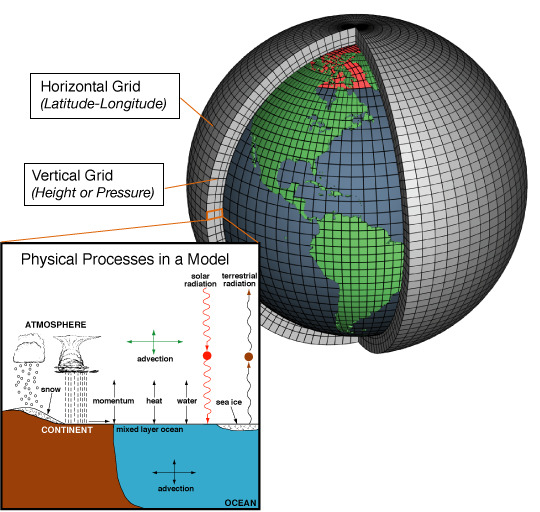
Solve a system of differential equations based on the laws of physics in each mesh cell
Until the 1970s,The advent of supercomputers made it possible to solve the full set of equations proposed by Abbe and BjerknesIn 1979, the European Centre for Medium-Range Weather Forecasts (ECMWF) compiled the first medium-range weather forecast, opening the chapter of the Integrated Forecasting System (IFS).
However, Edward N. Lorenz summarized the experience of his predecessors.Proposed that the weather system is a chaotic system, can change dramatically with a slight change in the variables. On the other hand,It is also difficult for people to fully understand the initial state of the meteorological system.To this end, the academic community uses ensemble forecasting to minimize the uncertainty of initial parameters and forecasting models. The collection of forecast results is the basis of probabilistic forecasting.

Schematic diagram of ensemble forecast of precipitation probability
With the development of numerical models, supercomputing, data assimilation and ensemble prediction technologies, the accuracy of numerical weather forecasts has been continuously improved, and the prediction time has gradually increased from 3 days and 5 days to 7 days and even 10 days..
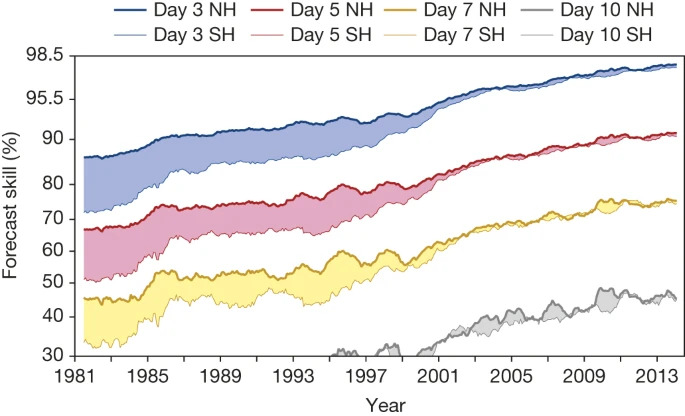
The evolution of weather forecasting technology over time in the Northern and Southern Hemispheres (SH, NH)
Currently, the ECMWF forecast model requires 10-day forecasts for 2 million grid cells at each horizontal layer with a 10-minute step, running twice a day.Therefore, they need to complete the calculation of about 40 billion grids within 2.5 hours, which requires very high computing costs.
High computational costs hinder further development of numerical weather prediction methodsHow to find a balance between model resolution and ensemble size has become a shackle that limits ensemble forecasts.
The rise of data-driven machine learning approaches
Recently,Data-driven machine learning (ML) shows great potential in weather forecasting. Since 2022, machine learning models in the field of weather forecasting have made a series of breakthroughs, some of which can rival the high-precision forecasts of the European Center for Medium-Range Weather Forecasts. Data-driven weather forecast reasoning relies on machine learning models rather than physical models in the Integrated Forecast System (IFS).Its prediction speed is several orders of magnitude faster than traditional methods.In addition, weather forecasts based on machine learning are the result of inductive reasoning rather than traditional deductive reasoning. This paradigm shift in logic has changed the way weather forecasts are interpreted.These results are more convincing because they are learned from previous data..
Dataset: 0.25° reanalysis data from 1940 to present
Data-driven models emerge thanks to large-scale, high-quality open meteorological datasetsThe existing machine learning weather forecast model is trained on the fifth generation reanalysis data of the European Centre for Medium-Range Weather Forecasts.ERA5 reanalysis datasetWhen the current version of the Integrated Forecast System (IFS) was launched in 2016, weather data from 1940 to the present were reanalyzed to produce the ERA5 dataset with a resolution of 0.25° (30 km).
FourCastNet: A DL model with comparable accuracy to IFS
In 2022, NVIDIA released FourCastNet, based on the Fourier prediction neural network.First deep learning weather forecast with 0.25° resolution.
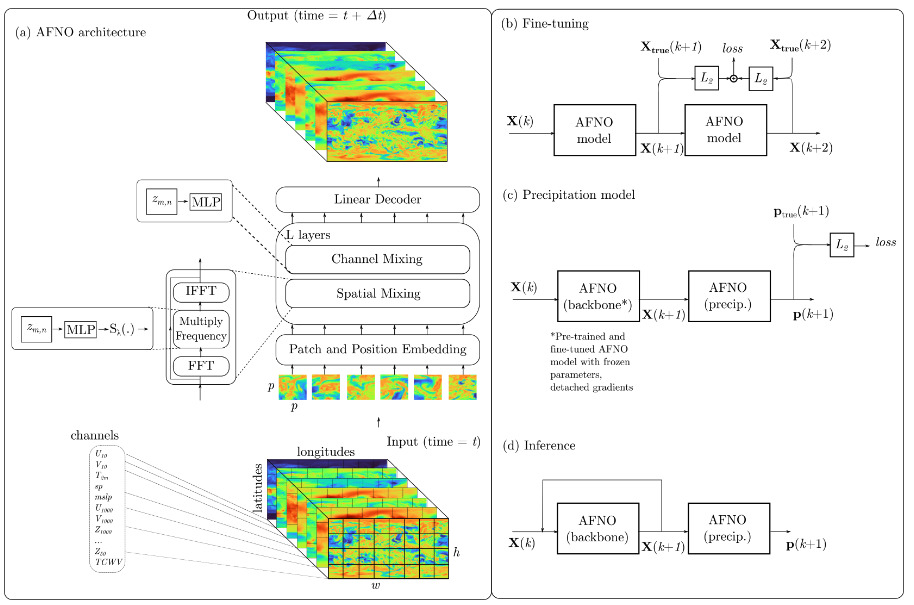
FourCastNet architecture diagram
While improving the resolution, FourCastNet is not far behind traditional numerical weather forecasting in terms of anomaly correlation coefficient (ACC) and root mean square error (RMSE).
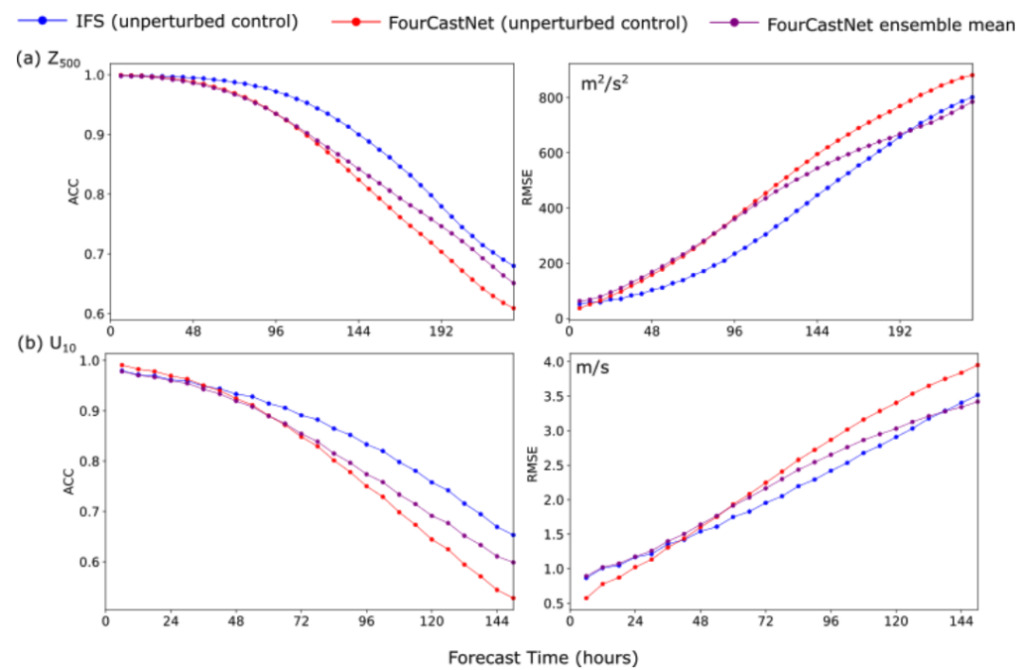
Comparison of ACC and RMSE between FourCastNet and numerical weather prediction
In Node-Hour,FourCastNet is approximately 45,000 times faster than traditional numerical weather prediction models, combined with its accuracy at high resolution, has led to a rapid reduction in the cost of very large-scale ensemble forecasts.
GraphCast: Global Medium-Term Weather Forecast Based on GNN
GraphCast is a neural network based on graph neural network (GNN).Adopting the "encode-process-decode" configuration, with a total of 36.7 million parameters.
The encoder maps the variables in the input grid to the internal multi-grid through a single layer GNN.
Multigrid is a spatially homogeneous graph, with high resolution at global scale. The multi-mesh is formed by 6 iterations of a regular icosahedron (containing 12 nodes, 20 faces and 30 edges), each iteration refines the mesh by dividing a single triangle into 4 smaller triangles and projecting their nodes onto the sphere.The final multi-grid contains 40,962 nodes, and the edges of all graphs during the refinement process, forming a hierarchical graph containing edges of different lengths.
The processor uses 16 non-shared GNN layers, message passing is performed on multiple grids. The decoder uses a single-layer GNN to map the processor's learned features from multiple grids back to the longitude and latitude system.
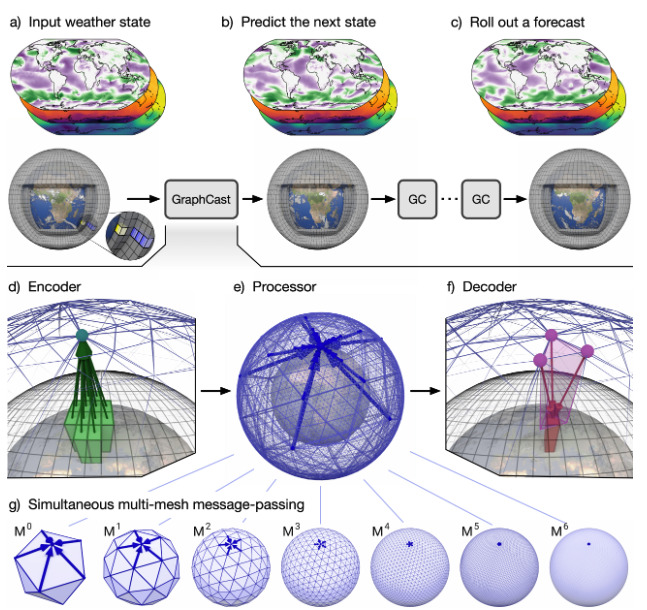
GraphCast Framework
ac: GraphCast’s input-prediction-iteration process;
df: GraphCast encoding-processing-decoding configuration;
g: Multi-grid refinement process.
Compared with the High Resolution Forecasts (HRES) of the European Medium-Range Weather Forecast,GraphCast outperforms both ACC and RMSE.

Comparison of prediction RMSE (a&b) and ACC (c) between GraphCast and HRES
After 3 weeks of training on 32 Cloud TPU v4 devices, GraphCast learned ERA5 data since 1979. GraphCast can generate a 10-day weather forecast with a resolution of 0.25° and a 6-hour interval on a single Cloud TPU v4 device in 60 seconds.
Pangu: A large 3D meteorological model based on ViT
The input and output of the Pangu meteorological model are both three-dimensional meteorological fields.Due to the uneven distribution of longitude and latitude of the meteorological field,The Pangu meteorological model uses the 3D Vision Transformer (ViT) to process meteorological data., its accuracy exceeded that of the mainstream integrated forecast system (IFS) for the first time.
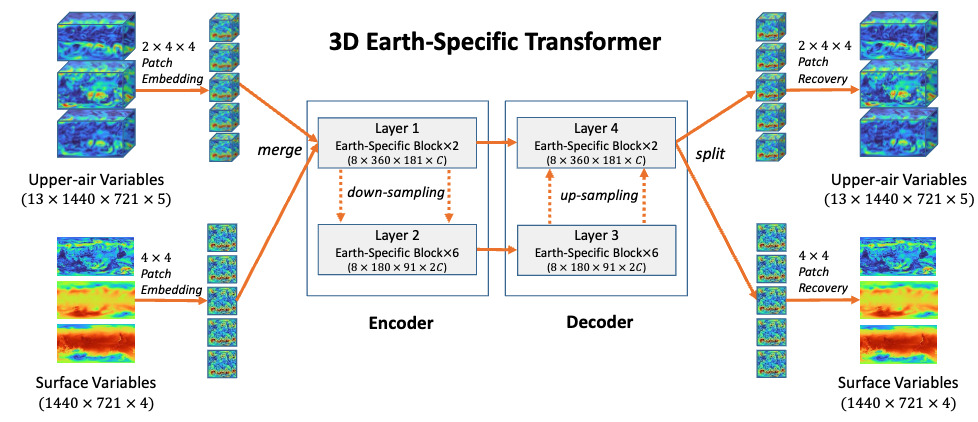
3D Vision Transformer Architecture
When the forecast time is longer than 3 days, from the RMSE point of view,The performance of Pangu Meteorological Model and IFS is comparable, which are better than the training set ERA5.
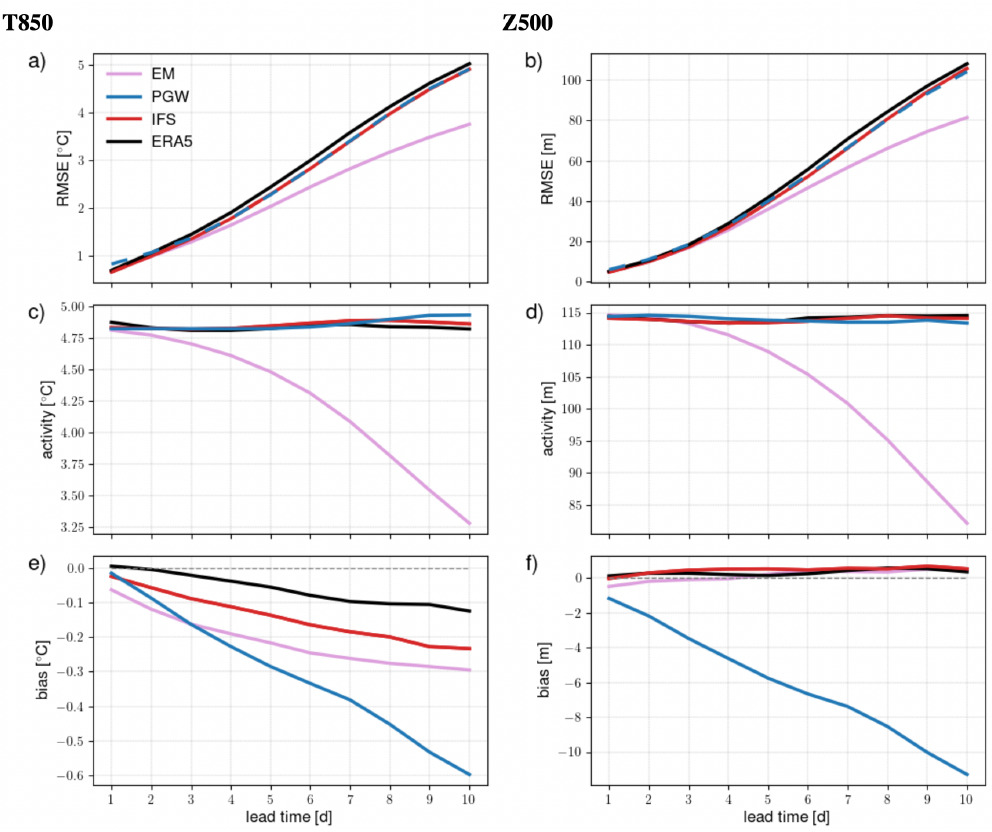
Comparison of prediction performance of different models for T850 and Z500
a&b: RMSE when different models predict T850 and Z500 respectively;
c&d: activity intensity predicted by different models at T850 and Z500, respectively;
e&f: Deviations when different models predict T850 and Z500, respectively.
In summary, data-driven machine learning weather forecasting is close to the traditional numerical weather forecasting model in terms of prediction accuracy, but the computing equipment and computing speed far exceed the numerical weather forecasting model, which shows that AI weather forecasting has considerable potential in practical applications.
Machine Learning and Numerical Prediction = Accuracy + Speed
Machine learning is advancing at a breakneck pace, both inside and outside of weather forecastingThe European Centre for Medium-Range Weather Forecasts has been following the rapid rise of data-driven weather forecasting with a number of other companies, including NVIDIA, Huawei and Deepmind.
“FourCastNet is the first AI-based weather forecast system with a resolution of 0.25° and the first open source weather forecast system. Our new version significantly improves the model’s medium-term performance and long-term stability, and hopes to achieve super-resolution through a neural operator framework,” said Anima Anandkumar of the NVIDIA Earth-2 team.
ECMWF presents these machine learning models, together with stable numerical models, to users, inviting them to evaluate the operation and performance of the systems from the application side.Model accuracy, reliability, uncertainty and interactivity are key factors in assessing the quality and effectiveness of meteorological products.
To this end, the European Centre for Medium-Range Weather Forecasts has made public the forecast results of FourCastNet, PGW and GraphCast based on IFS initial conditions. Florian Pappenberger said,Openness is the key to innovation, collaboration and exploration. By sharing data, methods and results, and conducting comparisons and analyses, we can accelerate scientific development and ultimately benefit society."
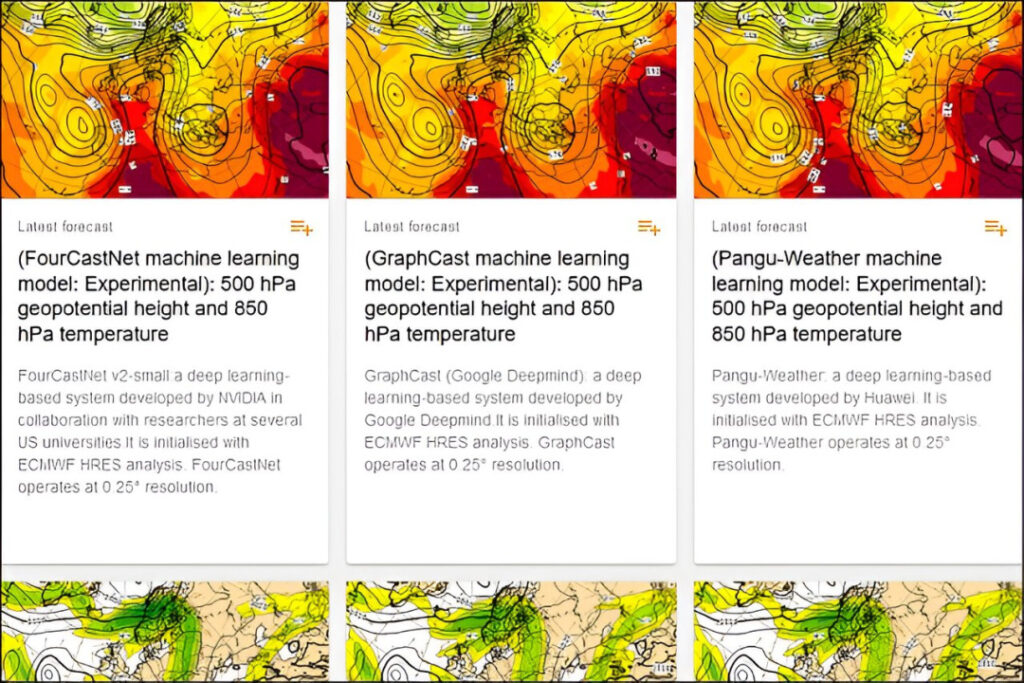
Three public data of meteorological AI
In the comparison of the European Center for Medium-Range Weather Forecasts, it can be seen that AI-based weather forecasting is comparable to numerical weather forecasting in some aspects and will play an important role in the future.These models do not yet have comprehensive forecasting capabilities, which is key to providing valuable forecasts on medium to long-term time scales.
Open access, comparison optimization, and portability, AI is infiltrating its advantages into traditional weather forecastingWhile freeing weather forecasting from supercomputers, AI also performs well in extreme climate events. I believe that AI can revolutionize weather forecasting together with numerical weather forecasting and contribute to the development of agriculture, forestry, animal husbandry, fishery, navigation and aerospace.
Reference Links:
[1]https://journals.ametsoc.org/view/journals/mwre/29/12/1520-0493_1901_29_551c_tpbolw_2_0_co_2.xml
[2]https://cir.nii.ac.jp/crid/1573668925699683328
[3]https://www.nature.com/articles/nature14956
[4]https://arxiv.org/abs/2202.11214
[5]https://arxiv.org/abs/2212.12794
[6]https://phys.org/news/2023-09-ai-weather-showcase-data-driven.html
[7]https://arxiv.org/abs/2307.10128
-- over--